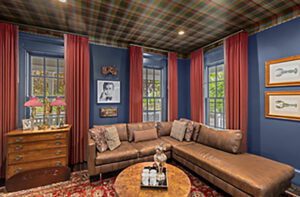Sounds of Silence
July 13, 2015
A contemporary compound is—literally and figuratively—a quiet presence on its coastal Maine site.
Text by Nathaniel Reade Photography by Trent Bell
A lot is surprising about the house that JT Bullitt built in Steuben, Maine. Bullitt eats strawberries, huckleberries, and blueberries that grow on his roof. He installed a seismometer on the bedrock under his meditation room. Most surprising of all, though, may be that he built his house with a primary focus on sound.
Bullitt is a 59-year-old deep-thinker and artist who once worked in geophysics and seismology, studying earthquakes and the structure of the earth’s interior. This, he says, left him fascinated with the deep vibrations the earth generates, often at a frequency too low for the human ear to detect. He uses his “sound art” to record and make audible these vibrations as a way to increase awareness of our planet’s natural music.
When you’re listening for the natural sounds of the planet, it helps to be somewhere that’s low on the sounds of humans. One summer while renting a cottage in Steuben, which is so far up the coast of Maine you can see Canada, he strolled around a property for sale. An old farmhouse stood on seventeen acres that sloped from a low hill down to the beach. The granite outcroppings, twelve-foot tidal drops, and black, star-speckled sky made him feel connected to the bedrock of the earth and the constant rhythms of the oceans and the planets. And aside from the wind, the birds, and the eternal breaking of the waves, it was deliciously, invitingly quiet. He knew this was the place, he says, when in a small cemetery on the property he saw a gravestone with this quote: “The earth has music for those who listen.” Someone before him had heard it, too.
Bullitt’s concern for the natural world meant that he wanted to reuse the old farmhouse, but it was too far gone. So he cast around for an architect who could “honor the site.” After many meetings with architects, and many rejected plans, he spotted an image of a backyard tree-house that Portland, Maine-based architect Will Winkelman had built for his kids. It was, Bullitt says, “simple, unusual, imaginative, and connected with the space.”
Winkelman suggested bringing in Todd Richardson, a landscape architect, to ensure that the house would be built with the land, and not just on it. “We do this on most of our projects,” Winkelman says. “So many of them are on land that’s gorgeous, and we want to meld the house into the landscape, not just build it and then shrub it up.”
The three of them and two assistants spent two days walking the land, discussing siting options, and drawing sketches. They went out in a boat to view the land from the water. The design process, Bullitt says, “was so much fun, it was like play.”
Bullitt dislikes the typical noises of a house—furnace kicking on, pipes draining—so the team designed an assembly of three buildings around a central courtyard, one of which holds all the utilities, another Bullitt’s living quarters, and the third his sound studio, the walls of which slope outward for better acoustics. Together these buildings mimic the way he land pours down from the hills to the shore; there’s a sense of motion. And the turf roof, which Richardson planted with native grasses, blueberries, huckleberries, and strawberries, lies over it like a blanket of “lifted field.”
The result, Bullitt says, is “intangible. It’s the perfect place to go inward, which is fitting, because I’m going into the earth to listen. Living there feels like falling in love.”
“JT wanted architecture,” Winkelman says, “but he also wanted performance.” So the house is net-zero, its geothermal heat-pumps, radiant-floor heat, and LED lights powered by a ground-mounted PV array, the windows triple-paned and sited to maximize solar gain and the miraculous views. The triple-pane glass and superinsulated walls make the inside spaces very quiet.
For most people in most places, that interior quiet would be an advantage. Bullitt, however, missed the natural sounds he moved there to hear. So he is currently devising a way to place microphones outside, collect the sounds of nature, and bring them in. Just like the gravestone said, this land has a music, and JT Bullitt is listening to it.
Share
![NEH-Logo_Black[1] NEH-Logo_Black[1]](https://b2915716.smushcdn.com/2915716/wp-content/uploads/2022/08/NEH-Logo_Black1-300x162.jpg?lossy=1&strip=1&webp=1)















You must be logged in to post a comment.